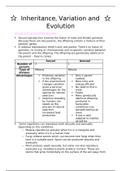Summary
Summary AQA GCSE Biology Inheritance, Variation and Evolution (Topic 6) Revision Notes
These are detailed Revision Notes for Topic Six (Inheritance, Variation and Evolution) of AQA GCSE Biology. They are written by me, using a combination of class notes, text books and revision guides. I have also uploaded the other chapters in my store.
[Show more]





